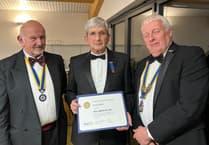Okehampton Rambling Club took a break from Dartmoor for their walk last Sunday, to head for a country park.
Members swapped familiar moorland trails for the more gentle inclines of Devon County Council-owned Stover Country Park, situated between Bovey Tracey and Newton Abbot, a site of special scientific interest and local nature reserve.
The 114 acres of woodland, lakeside paths, heathland and grassland were designated as a hotspot for dragonfly by the British Dragonfly Society in 1984.
The lake is home to an abundance of wildfowl and at this time of the year, it was lovely to see swans, coots and moorhens with their young.
Twenty-three members joined this mostly level walk of 6.5 to 7 miles with plenty of stops along the way to appreciate the variety of flora and fauna and to learn a little of the history of the country park.
Much of the route was along the Heritage Trail and the Templer Way. The circular 4.5-mile Heritage Trail around the estate and Stover Canal follows the Templer Way at many points. Part of the walk was in open countryside before returning to the lakeside. A short, delightful detour from the path was on the Stover Country Parks Aerial Walkway.
James Templer, son of an Exeter tradesman, was apprenticed at 14 to a city architect and eventually made his fortune as a naval dockyard contractor.
He bought Stoford Lodge and the Manor of Teigngrace in 1765 where he built Stover House which is now an independent school.
The 16-mile Templer Way trail follows the route of the quarried granite which was brought off the moor by the family owned Haytor Granite Tramway and moved down the Stover Canal on wind driven barges out to sea via Teignmouth.
Shortly after leaving the visitor centre the group stopped in the forest to admire the magnificent Horse and Carriage Sculpture created by Nick Mussell of The Tanglewood Project.
The sculpture represents the historic image of a horse and carriage which would have been a common sight along the Carriageway Drive to Stover House.
Poet Ted Hughes had long-standing links with Devon and a trail has been created in the park to celebrate his poetry.
Visitors can see and read the 16 poetry posts erected in the park displaying some of his works which relate to the natural world and in particular, the wildlife seen and heard around the park.
The Templer Way follows the disused Stover Canal built in 1790-92 to carry ball clay, later granite. The canal was fed by Ventiford Brook on the other side of the path.
A replica of the crane which would have been used for lifting granite was built using a single oak tree and erected on the quayside of the Ventiford Basin (the terminus of the canal) and unveiled in September 2021.
An 1848 map shows The Hope Inn, built on the other side of the basin which would have been used by tramway and canal workers.
The group stopped at various other historical structures that would once have played a vital role in the workings of the canal.
Towards the end of the walk, the group came across the Canadian Forestry Memorial Sculptures.
Known as the Sawdust Fusiliers, a battalion of 16,000 men were recruited in 1916 to cut down trees in Britain to supply fighting forces on the front lines of Belgium and France. The timber was needed to make trenches, dug-outs, roads, railways sleepers, huts, planking posts, ammunition boxes and for fuel.
German U-boats prevented the import of timber from Canada and as there were few skilled workers left in the UK the Canadians were recruited to carry out this important war work.
Shortly after passing through Teigngrace, the walkers returned to their cars and made their way to Bovey Tracey for welcome refreshments.
As ever, new walkers are always welcome at the Sunday walks. Meet at the post office in George Street, Okehampton ready to leave at 9.30am. Please be there in plenty of time so that the group can leave promptly. Where possible, we try to share cars though this cannot be guaranteed. You should be suitably attired for all weather conditions, including sturdy footwear and bring a packed lunch.




